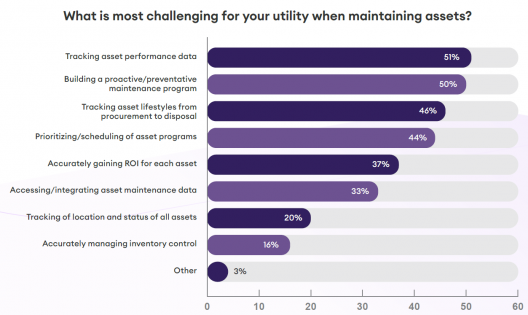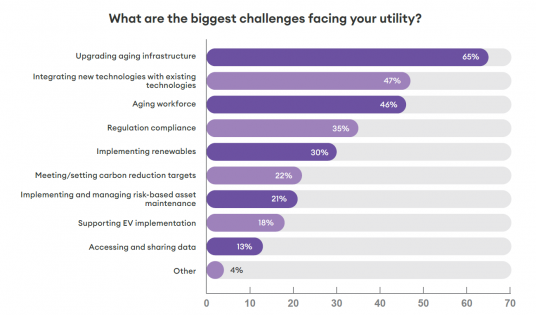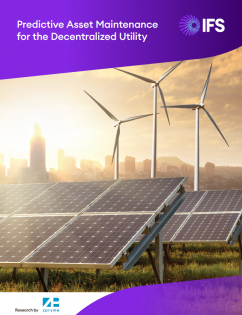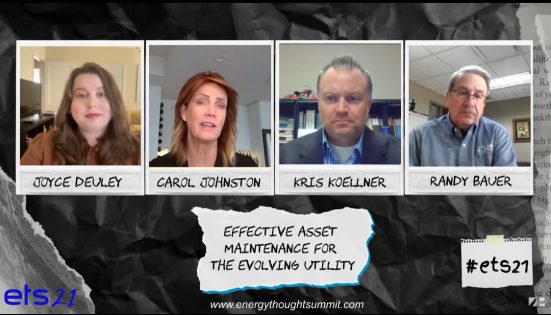To better manage grid operations, many utilities are turning to risk-based predictive asset maintenance and monitoring technologies
The transition to decentralization is coming, whether utilities are fully prepared to make the shift or not. In order to better manage their grid operations, many utilities have turned to risk-based predictive asset maintenance and monitoring technologies, yet some utilities continue to rely on traditional scheduled, or reactive, asset management strategies, leaving a lot on the table. Compounding problems for those neglecting to be proactive are the increasing number of renewable energy sources and the rise of the “prosumer” relationship with customers, which makes asset management even more challenging for utilities already swamped by operational data, creating a lack in actionable intelligence.
IFS partnered with energy research firm Zpryme to survey more than 100 utilities to better understand this shifting landscape. The findings discuss how to move away from a break-fix model within an asset maintenance strategy and explores the changing dynamic between utilities and customers.
Key Findings
- Building a proactive/preventative maintenance program (50%) is among the top three challenges for utilities when maintaining assets
- 46% of utilities have implemented a predictive, risk-based asset maintenance program within the last few years
- The top challenges of integrating a predictive asset maintenance program are software maturity or availability and sufficient budget (44%, respectively)
- 33% of utilities have implemented or are currently implementing a home services program within the last three years for behind-the-meter assets
Framing the Problem
Utilities face a variety of challenges as they fight to keep the lights on for themselves and others. When asked about their top challenges, respondents said that upgrading infrastructure was by far the most pressing (65%), followed by the integration of new technologies with existing technologies (47%) and an aging workforce (46%).
Despite concerted efforts to modernize the grid, replacing infrastructure has proven difficult. Retrofitting existing infrastructure is costly, compounded with having to balance distributed assets and manage stranded assets. Considering the growing integration of renewables onto the grid as well, it’s no wonder utilities haven’t been able to fully modernize. Additionally, utilities are challenged by a workforce that is aging out, taking valuable skills and knowledge with them, which will make managing the grid as we know it very difficult moving forward.
Operationally, utilities recognize the need to implement new technologies and solutions to improve efficiency and overall performance, but the marriage of legacy systems with nascent ones has proved particularly challenging. The need to maintain regulatory compliance with a shifting policy landscape doesn’t help matters (35%), particularly when upgrading physical and digital infrastructure is costly and hard to get right. As part of the push to modernize and remain compliant, more and more utilities are turning to connected device solutions to better monitor and manage various aspects of their grids. Yet 21% of utilities say they’re struggling with implementing and managing risk-based asset maintenance and management programs, and 13% have indicated complications with access and sharing data, which is critical for utilities to be able to decentralize their operations and management.
Layering on the complications of a changing climate and the push for more sustainable sources of energy, and therefore more sustainable management of existing resources, utilities are hard-pressed to balance all of these complexities. Nearly a third of utilities say they have challenges around incorporating renewables onto their grid. This number is expected to increase as more customers take a proactive role in the generation of energy via renewables and is set to permanently alter the relationship between utilities and consumers.
Predictive Asset Maintenance
When managing and maintaining assets, utilities have issues with tracking asset performance data (51%), building a proactive/preventative maintenance program (50%), and tracking asset lifecycles from procurement to disposal (46%). Additionally, utilities are struggling to extract full return on investment (ROI) from each asset (37%) as well as accessing/integrating asset maintenance data (33%). In traditional asset management, utilities don’t have real-time visibility of their assets, meaning that they only know if there’s a failure when something goes wrong. This break-fix model can end up being more costly for utilities versus taking a more proactive approach via predictive maintenance solutions.

Utilities are stuck between a rock and a hard place, balancing operational and sustainability challenges and more. Between the difficulty in sourcing mature software, to integration within legacy systems, to accessing and sharing data, utilities are finding it difficult to justify investing in predictive, risk-based asset maintenance solutions. This is exacerbated by the climate-related effects on distributed assets and the increasing number of assets as renewable energy sources come onto the grid.
But the benefits of deploying a predictive asset maintenance program are unparalleled when it comes to the visibility of assets and the ability for the utility to fully actualize the ROI of each asset. Overall, utilities can expect to see improved system reliability and resilience, reduced outages and failures, along with reduced repair times and improved worker safety. This will be necessary, particularly in light of the rise of the prosumer and the expansion of the grid as we know it. The liability of external assets will increase burdens on the utility, especially when it comes to asset failures.
By deploying a comprehensive home services program, utilities can reduce the liability of and increase visibility of distributed energy resources (DERs) and improve customer satisfaction and experience.
Get your copy of the full Zpryme report, including their recommendations for the utility industry.
Watch the industry panel discuss the Zpryme report findings at the Energy Thought Summit
Follow us on social media for the latest blog posts, industry and IFS news!


